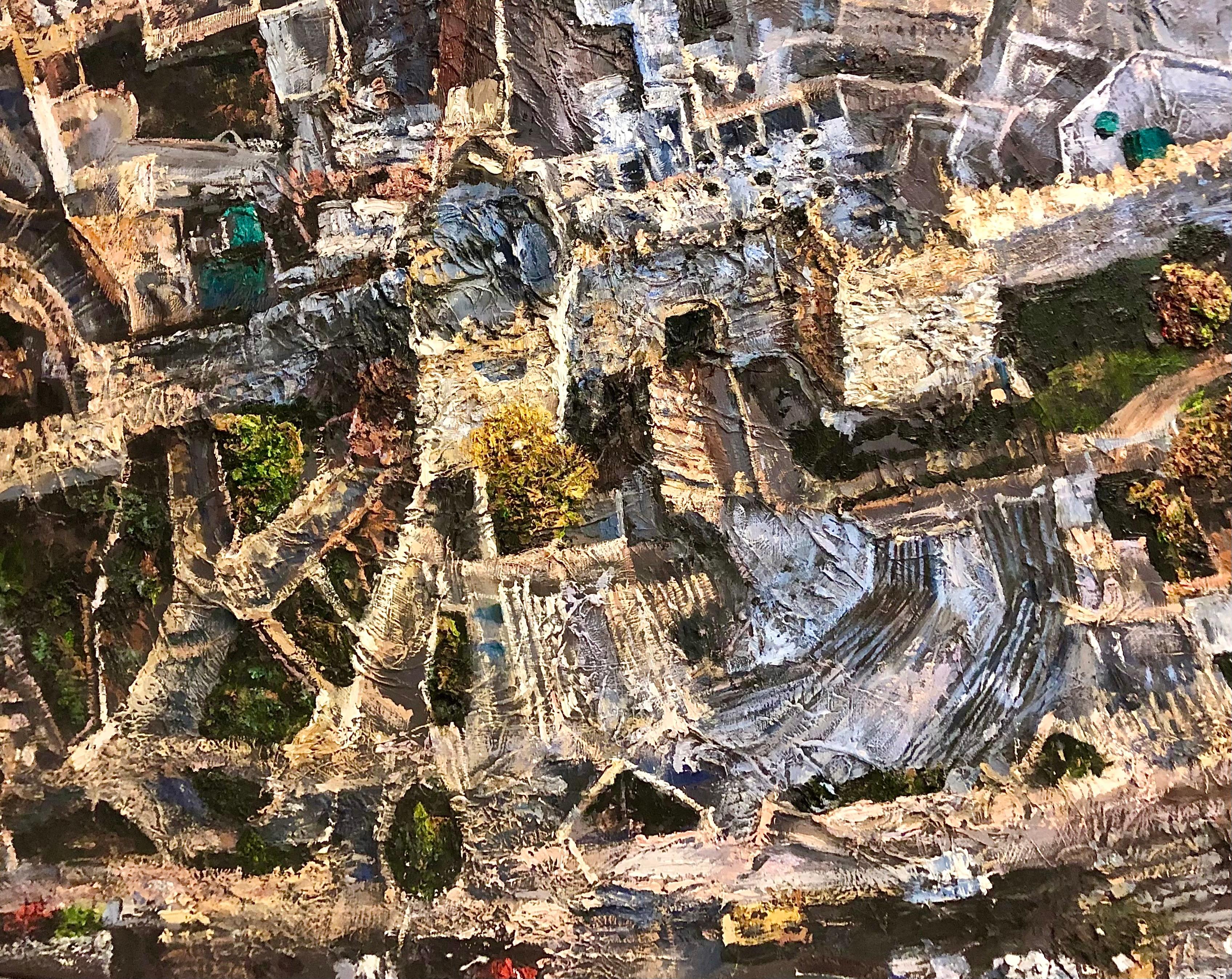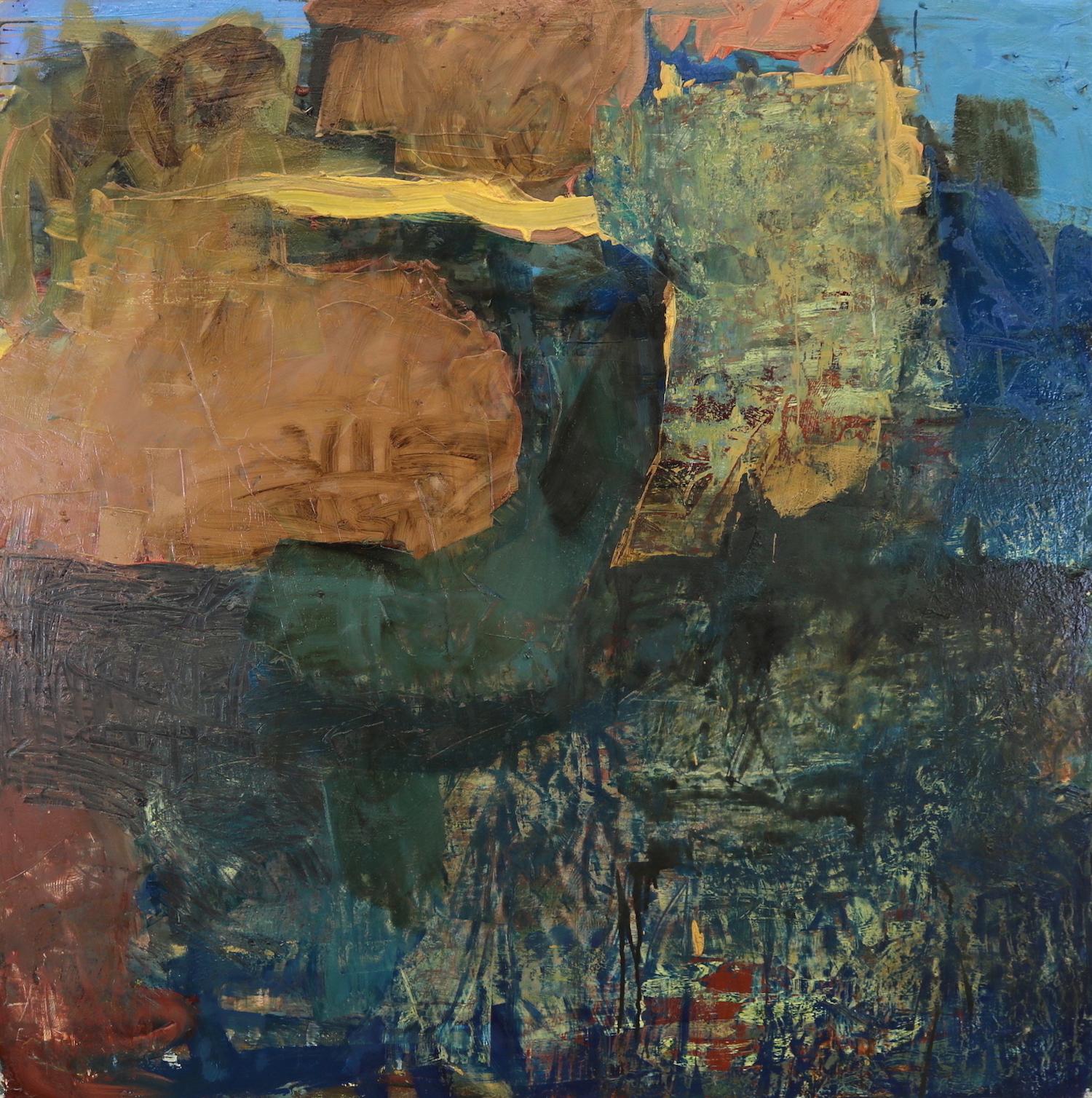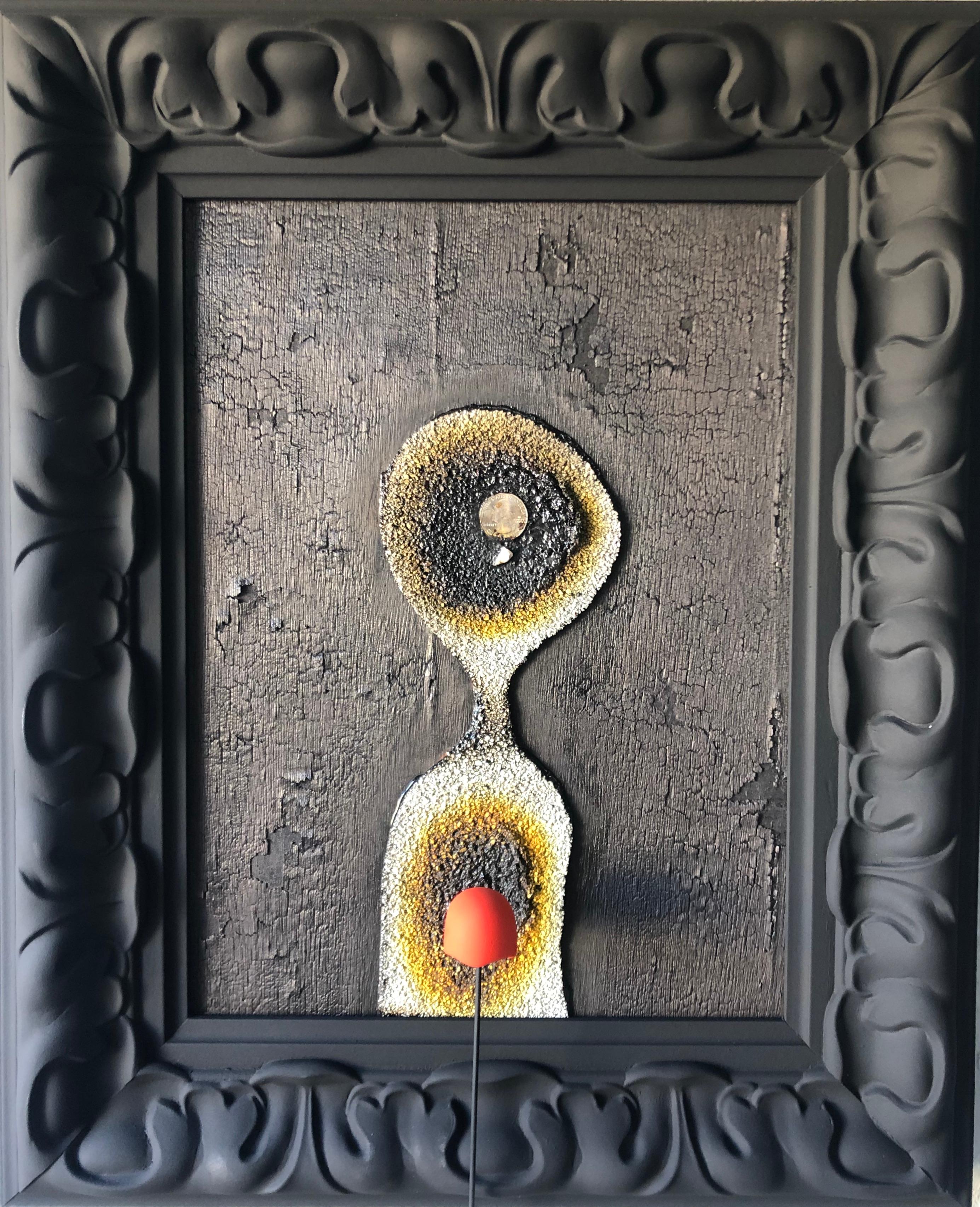Items Similar to Mann und Frau
Want more images or videos?
Request additional images or videos from the seller
1 of 4
Franz EckerMann und Frau
About the Item
Seit seinem frühen Tod 1999 erlebt das Werk von Franz Ecker eine längst fällige Neubewertung, die sich auch in zahlreichen Einzelausstellungen, Katalogen und einem sehenswerten Kinofilm manifestiert. Der extrem produktive Maler hinterließ ein fast unüberschaubares Oeuvre mit einer extremen stilistischen Breite und einer ganzen Reihe von Spitzenwerken, die ihresgleichen in der jüngeren österreichischen Kunstgeschichte suchen und deren Stellenwert noch nicht hinreichend erfasst ist.
Als Franz Ecker 1966 nach dem Studium bei Sergius Pauser mit zwei Staatspreisen nach Leonding zurückkehrt, hat er bereits eine klare abstrakte Formensprache ausformuliert. Als
Inspirationsquelle sind Czeanne und Picasso zu nennen, als Lehrer unbedingt aber auch Martin Polasek. Sie führen zu einer flächenbetonten abstrakten Malerei, die durch exakte farbliche Abstimmung und strenge Komposition eine räumliche Erfahrung auslöst. Ihre stärksten Momente erlebt Franz Eckers Malerei dabei an der Grenze zwischen Gegenständlichkeit und Abstraktion. Nur in der Zeit bis ca. 1975 gibt es dazu auch eine Vielzahl Aquarelle, wobei Ecker dieses Medium für besonders lyrische Arbeiten nutzt.
Wenn Franz Ecker dennoch nicht zum Kanon der Avantgarde der 70er-Jahre gerechnet wird, so deshalb, weil er sich dem Kunstmarkt bis zur Selbstaufgabe verweigert hat. Statt die
Möglichkeiten zu nutzen, die ihm in Wien geboten werden, geht er nach der Akademiezeit wieder zurück nach Linz, das damals für sein Werk weder Verständnis noch Markt bietet. Vom etablierten Kunstbetrieb abgeschnitten, lebt Ecker kompromisslos das prekäre Leben eines einsamen Genies. Ein Künstler-Mythos, der in seinem Fall freilich bittere Realität ist.
Davon unbeeindruckt, erarbeitet sich Ecker eine immer breitere Formensprache innerhalb der klaren Linie der abstrakten Bildauffassung, was er auch mit ständig neuen Signaturformen unterstreicht.
Ende der siebziger Jahre werden seine Arbeiten gestischer und expressiver. Werke wie etwa Eckers „Kafka“ nehmen die „Neuen Wilden“ vorweg. Als diese einige Jahre später als “Rückkehr der Malerei“ gefeiert werden, bemerkt Franz Ecker voller Selbstbewusstsein in einem Interview, dass er hier nicht viel Neues erkennen könne. Er sei wohl immer noch „ein Einäugiger unter Blinden“.
Franz Ecker hat zu diesem Zeitpunkt seinen Stil bereits zu einer stark strukturierten Flächigkeit weiterentwickelt, die öfters mit Keith Haring verglichen wird. Für Museen, Kuratoren, Kunsthistoriker und Sammler hinterlässt Ecker ein Werk, das noch alle Möglichkeit der Deutung, Neubewertung, ja der Entdeckung zulässt.
- Creator:Franz Ecker (1943 - 1999)
- Dimensions:Height: 33.67 in (85.5 cm)Width: 43.51 in (110.5 cm)
- Medium:
- Movement & Style:
- Period:
- Condition:
- Gallery Location:Wien, AT
- Reference Number:1stDibs: LU1782212691072
About the Seller
No Reviews Yet
Vetted Seller
These experienced sellers undergo a comprehensive evaluation by our team of in-house experts.
Established in 1973
1stDibs seller since 2022
5 sales on 1stDibs
- ShippingRetrieving quote...Ships From: Wien, Austria
- Return PolicyA return for this item may be initiated within 7 days of delivery.
More From This SellerView All
- Wooden HeadsLocated in Wien, 9Since Franz Ecker’s early death in 1999 his work has been newly appreciated, what is manifested in numerous exhibitions, catalogues and in the acclaimed film about the artist. He was extremely productive and left behind an almost unmanageable scope of works in various styles. Among them some of the top works that are unparalleled in recent Austrian art history and whose significance has not yet been adequately appreciated. After finishing his studies in 1966 in class of prof. Sergius Pauser and after receiving his two prizes, Franz Ecker moved back to Leonding where he developed his clear, abstract language of forms. Among his sources of inspiration are Cezanne and Picasso, as well as Martin Polasek who was one of his teachers. This led him to painting in a flat and abstract manner, which triggers a spatial experience through its exact color coordination and strict composition. The strongest period in his oeuvre is the time when his paintings are between figuration and abstraction. Only until around 1975 he additionally creates numerous watercolors, even though he restricts this medium to his more lyrical works. If Franz Ecker cannot be included in the avant-garde cannon of the 70’s, it is only because he witheld from presenting his works on the art market. Instead of using the opportunities that were offered to him in Vienna, he returned after his time at the academy to Linz where there was no appreciation nor market for his works. Distanced from the established art business, Ecker lives uncompromisingly the precarious life of a lonely genius. An artist myth, which in his case certainly is a bitter reality. Unimpressed by this, Ecker develops an increasingly broad language of forms within the clear line of abstract pictorial conception, which he emphasizes with constantly new forms of signature. At the end of the seventies his works became more gestural and expressive. His works like “Kafka” anticipate the “Neue Wilden”. When these are celebrated as the “return of painting...Category
Late 20th Century Abstract Abstract Paintings
MaterialsPaint, Oil, Panel, Wood Panel
- NudeLocated in Wien, 9Seit seinem frühen Tod 1999 erlebt das Werk von Franz Ecker eine längst fällige Neubewertung, die sich auch in zahlreichen Einzelausstellungen, Katalogen und einem sehenswerten Kinof...Category
Late 20th Century Abstract Abstract Paintings
MaterialsOil, Wood Panel
- Ohne TitelLocated in Wien, 9Seit seinem frühen Tod 1999 erlebt das Werk von Franz Ecker eine längst fällige Neubewertung, die sich auch in zahlreichen Einzelausstellungen, Katalogen und einem sehenswerten Kinof...Category
Late 20th Century Abstract Abstract Paintings
MaterialsOil, Wood Panel
- Komposition 3Located in Wien, 9Seit seinem frühen Tod 1999 erlebt das Werk von Franz Ecker eine längst fällige Neubewertung, die sich auch in zahlreichen Einzelausstellungen, Katalogen und einem sehenswerten Kinof...Category
Late 20th Century Abstract Abstract Paintings
MaterialsOil, Wood Panel
- PabhobecneLocated in Wien, 9The avant-garde artist Vladimir Sterligov created his own system of forms and symbols here. These, as well as his other constructions, deal with non-representational reality. The two...Category
1920s Modern Abstract Paintings
MaterialsOil, Wood Panel
- Die Benno Kirche - Benno ChurchBy Fritz BaumgartnerLocated in Wien, 9The painter was born in Austrian, but grew up in Munich and died in 2006 at the age of 77. He was an outstanding personality, atypical in the German art landscape. He started on the ...Category
Early 2000s Expressionist Abstract Paintings
MaterialsAcrylic, Wood Panel
You May Also Like
- Colorful Abstract Aerial Landscape PaintingLocated in East Quogue, NYStunning textural abstract aerial landscape painting by Hungarian artist Levente Baranyai. Oil on panel, 37.5 x 50 inches. With a focus on aerial urb...Category
1990s Abstract Landscape Paintings
MaterialsOil, Wood Panel
- "Birds And Bees" oil saw dust and foam on wood by Steven RehfeldBy Steven H. RehfeldLocated in Carmel, CASize: 4ft x 8ft Mixed Media: oil, saw dust and foam on wooden panel. Steven is now one of the top emerging artists in the U.S. His works are ground breaking, bold and imbued with u...Category
21st Century and Contemporary Abstract Abstract Paintings
MaterialsOil, Foam, Mixed Media, Wood Panel
- "Point of Departure 2", abstract, blues, greens, pink, mixed media paintingBy Leslie ZelamskyLocated in Natick, MALeslie Zelamsky's "Point of Departure 2" is a 42 x 42 x 2.75 inch mixed-media painting on wood panel. This abstract painting contains an assortment of ...Category
2010s Abstract Abstract Paintings
MaterialsWood Panel, Oil, Mixed Media, Tar, Graphite
- Randi Joe In The SnowBy Randi GranthamLocated in Lake Worth Beach, FLRandi Joe in the snow. Mixed Media oil paint, paint, pigment, crystal rock, wood panel artist unique style and technic, the frame is part of the artwork. Randi Grantham...Category
2010s Abstract Abstract Paintings
MaterialsMixed Media, Oil, Wood Panel
- The Forgotten AmericaBy Randi GranthamLocated in Lake Worth Beach, FLThe Forgotten America. Mixed Media oil paint, tar, gravel. metal, resin on wood panel artist unique style and technic, the frame is part of the artwork. Randi Grantham...Category
2010s Abstract Abstract Paintings
MaterialsTar, Oil, Mixed Media, Wood Panel
- Beneath the NightBy Jessica HoustonLocated in Montreal, QuebecJessica Houston’s most recent works look north. What is north? Where is it? Is it a fixed place, or something else? Her second solo show at Art Mûr brings together paintings, a sound sculpture, and chine collé prints, all of which reveal a fragile, fluid, and often fractured, north. An iron ore stone becomes a speaker, playing recordings of interviews and singing, and expanding the physical presence of the stone. The exaggerated textures of the paintings give them, too, a sculptural and documentary feel. They record how actions—breaking and piercing, pushing and pulling—disrupt and transform the paintings’ surfaces. By resembling patterns one finds in the wild—scratches across the surface of a rock, uneven waves that form on melting snow—they unhinge any clear distinction between what is natural and what is made. Made with a printmaking technique that binds together distinct papers, the chine collé prints begin with photographs Houston took of Baffin Island. She then combines the images with coloured paper, creating traces of the process of extracting and replacing parts of a scene, and an equal awareness of both what is present and absent. Some are composed of double circles, like looking through binoculars. In Business As Usual, a decaying interior—peeling wallpaper, a rusted stove—is juxtaposed with the soft glow of a yellow circle. This continues Houston’s ongoing use of colour to question the particulars of perception. Heritage of All, White with Greed and Iron, and The Spaces we Breath, Houston’s titles read like lines of a haiku. Composed as prose, they are also confrontational, mapping out the cultural and environmental impacts of the extraction of resources in the Arctic. We witness scenes of violent decay, and yet simply carry on, like Business As Usual. In What Nations Come and Go a pale purple oval nearly fills the frame, revealing only in the very far right a simple cabin in front of a rocky incline. A similar imposing cloud of colour, this time blue, dominates the landscape in Mapped, Claimed, and Evaluated. The north is just as much an idea as it is a place, and is one that looms large in the Canadian imagination. There are few better examples than Glenn Gould...Category
2010s Abstract Abstract Paintings
MaterialsOil, Wood Panel





